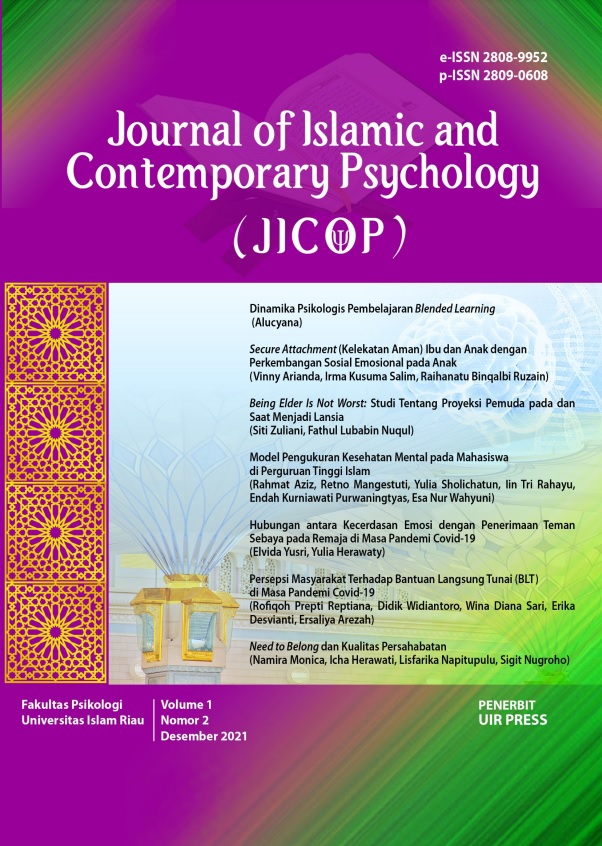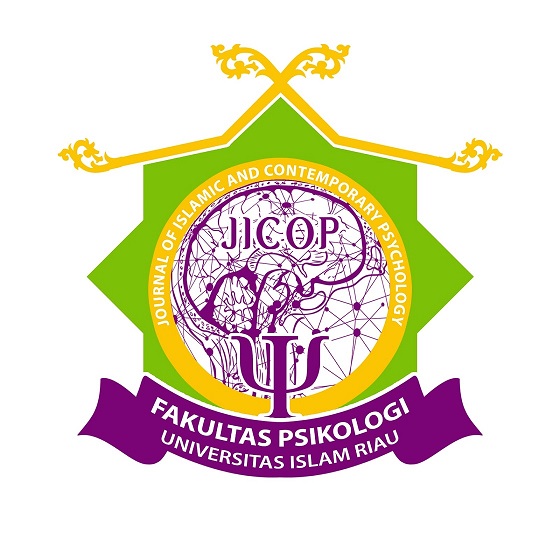Being Elder is Not Worst: Studi Tentang Proyeksi Pemuda Pada dan Saat Menjadi Lansia
DOI:
https://doi.org/10.25299/jicop.v1i2.8387Keywords:
Projection, Youth, ElderlyAbstract
The projection of becoming elderly is one of the things that young people rarely think about in facing the next phase. The purpose of this study was to analyze the projections of youth into the elderly, which include attitudes and readiness to care for the elderly, youth expectations when they become elderly, and the efforts made to face the elderly. The research involves 224 people, about 17-24 years of age. The gender distribution was 75 males and 149 females. Data collection using an open questionnaire. The analysis used is theme/categorization analysis and descriptive analysis. The results show that youth who care for the elderly are not necessarily ready to become elderly. Both prepared and unprepared, both groups of subjects hope to have a prosperous life, have financial independence, and have a happy family.
Downloads
References
Afrizal, A. (2018). Permasalahan Yang Dialami Lansia Dalam Menyesuaikan Diri Terhadap Penguasaan Tugas-Tugas Perkembangannya. Islamic Counseling: Jurnal Bimbingan Konseling Islam, 2(2), 91. https://doi.org/10.29240/jbk.v2i2.462 DOI: https://doi.org/10.29240/jbk.v2i2.462
Ekowati, C. R. (2011). Penyesuaian diri terhadap hilangnya pasangan hidup pada lansia. Jurnal Keperawatan Lansia, 1–138.
Firman. (2015). Analisis Data Dalam Kualitatif. Article, 4, 1–13.
Hurlock, E. B. (1991). Masa - Masa Remaja. In Psikologi Perkembangan (pp. 205–243).
Indarwati, R. (2020). Lindungi Lansia dari Covid-19. Jurnal Keperawatan Komunitas, 5(1), 2020.
Indonesia, U. P. (2016). Faktor-Faktor Yang Mendasari Stres Pada Lansia.
Jurnal Penelitian Pendidikan UPI, 16(1), 124302.
Karomah, N. N. (2015). Hubungan Tingkat Spiritual Dengan Kecemasan Terhadap Kematian Pada Lansia Yang Memiliki Penyakit Kronis.
Misnaniarti, M. (2017). Situation Analysis of Elderly People and Efforts To Improve Social Welfare in Indonesia. Jurnal Ilmu Kesehatan Masyarakat, 8(2), 67–73. https://doi.org/10.26553/jikm.2017.8.2.67-73 DOI: https://doi.org/10.26553/jikm.2017.8.2.67-73
Naafs, S., & White, B. (2012). Generasi Antara : Re fl eksi tentang Studi Pemuda Indonesia * Pemuda sebagai Generasi Orang muda adalah aktor kunci dalam. I(2), 89–106. https://journal.ugm.ac.id/jurnalpemuda/article/viewFile/32063/19387
Nugroho, A. (2020). Persepsi Anak Muda Terhadap Keberadaan Lansia Di Indonesia. Journal of Urban Sociology, 2(2), 44. https://doi.org/10.30742/jus.v2i2.996 DOI: https://doi.org/10.30742/jus.v2i2.996
Ratnawulan, T. (2018). Perkembangan dan Tahapan Penting dalam Perkembangan. Journal of Special Education, IV(01), 65–74.
Siagian, T. H. (2020). Corona Dengan Discourse Network Analysis. Jurnal Kebijakan Kesehatan Indonesia, 09(02), 98–106.
Wiyono, J., Sahar, J., & Wiarsih, W. (2008). Pengalaman Keluarga Merawat Lansia dengan Tingkat Ketergantungan Tinggi di Rumah, Kota Malang, Jawa Timur: Studi Fenomenologi. Jurnal Keperawatan Indonesia, 12(2), 76–83. https://doi.org/10.7454/jki.v12i2.204 DOI: https://doi.org/10.7454/jki.v12i2.204
Yuhono, P. (2017). Gambaran peran keluarga dalam merawat lansia dengan ketergantungan di desa pabelan. Skripsi, 1–17. http://eprints.ums.ac.id/51710/1/Naskah Publikasi.pdf
https://www.psychiatrictimes.com/view/growing-crisis-mental-health-among-nations-elderly
https://www.solopos.com/kisah-sedih-ibu-asal-magelang-diabaikan-anak-dikirim-ke-panti-jompo-1184172
Downloads
Published
How to Cite
Issue
Section
License
This work is licensed under a Creative Commons Attribution - ShareAlike 4.0 International License (CC BY-SA)
This is an open-access article distributed under the terms of the Creative Commons Attribution-ShareAlike 4.0 International License which permits unrestricted use, distribution, and reproduction in any medium. Copyrights of all materials published in Journal of Islamic and Contemporary Psychology (JICOP) are freely available without charge to users or / institution. Users are allowed to read, download, copy, distribute, search, or link to full-text articles in this journal without asking by giving appropriate credit, provide a link to the license, and indicate if changes were made. All of the remix, transform, or build upon the material must distribute the contributions under the same license as the original.








